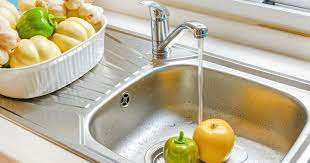Introduction
The kitchen sink is a focal point in any kitchen, serving as a hub for food preparation, cooking, and cleanup. Choosing the right kitchen sink involves considering various factors, including materials, styles, and functionality. Whether you’re remodeling your kitchen or building a new home, selecting the perfect sink can enhance both the aesthetics and functionality of your space.
Materials for Kitchen Sinks
When it comes to kitchen sink materials, there are several options available, each with its own unique characteristics and benefits. Common materials include stainless steel, cast iron, composite granite, fireclay, and copper. Understanding the pros and cons of each material can help you make an informed decision based on your needs and preferences.
Stainless Steel Sinks
Stainless steel sinks are a popular choice for modern kitchens due to their durability, versatility, and affordability. They are resistant to stains, rust, and corrosion, making them ideal for busy households. Stainless steel sinks come in various gauges and finishes, allowing homeowners to customize their kitchen sink to match their style and preferences.
Cast Iron Sinks
Cast iron sinks have a timeless appeal and are known for their durability and classic design. These sinks are coated with enamel, which provides a glossy finish and protects the iron from corrosion. Cast iron sinks are available in a range of colors and styles, making them suitable for both traditional and contemporary kitchens.
Composite Granite Sinks
Composite granite sinks are crafted from a mixture of crushed granite stone and resin, resulting in a durable and scratch-resistant material. These sinks offer the look and feel of natural stone without the maintenance requirements. Composite granite sinks come in a variety of colors and finishes, allowing homeowners to achieve a custom look in their kitchen.
Fireclay Sinks
Fireclay sinks are made from a mixture of clay and glaze, which is fired at high temperatures to create a durable and non-porous material. These sinks are known for their elegant appearance and traditional farmhouse style. Fireclay sinks are available in a range of colors and designs, making them a versatile option for any kitchen.
Copper Sinks
Copper sinks add warmth and character to any kitchen with their unique patina and antimicrobial properties. These sinks develop a rich patina over time, giving them a distinctive appearance that complements both modern and rustic kitchen designs. Copper sinks are naturally resistant to bacteria and corrosion, making them a hygienic and durable choice for the kitchen.
Styles of Kitchen Sinks
In addition to choosing the right material, homeowners must also consider the style of the kitchen sink. Common styles include undermount, drop-in, farmhouse, and apron-front sinks. Each style offers its own set of advantages and disadvantages in terms of installation, maintenance, and aesthetics.
Choosing the Right Size and Configuration
Selecting the right size and configuration of a kitchen sink is essential for maximizing functionality and efficiency in the kitchen. Factors to consider include the size of your kitchen, your cooking and cleaning habits, and the number of people in your household. Whether you prefer a single or double basin sink, it’s essential to choose a size and configuration that meets your needs.
Additional Features and Accessories
When choosing a kitchen sink, consider optional features and accessories that can enhance its functionality and convenience. Built-in drainboards, cutting boards, and grid racks are popular accessories that can help streamline food preparation and cleanup tasks. By incorporating these accessories into your kitchen sink setup, you can create a more efficient and organized workspace.
Budget Considerations
Budget is an important consideration when selecting a kitchen sink, as prices can vary significantly depending on the material, style, and brand. Stainless steel sinks are typically the most affordable option, while copper sinks tend to be more expensive due to their unique properties and craftsmanship. When budgeting for a kitchen sink, consider both upfront costs and long-term maintenance expenses to ensure you’re getting the best value for your investment.
Installation and Maintenance
Proper installation and maintenance are essential for ensuring the longevity and performance of your kitchen sink. While some homeowners may choose to install a sink themselves, hiring a professional can ensure that the job is done correctly and efficiently. Additionally, regular cleaning and maintenance are necessary to keep your sink free of stains, scratches, and bacteria. Be sure to follow manufacturer guidelines and recommendations for cleaning and care to preserve the beauty and functionality of your kitchen sink for years to come.
Conclusion
Choosing the right kitchen sink involves careful consideration of materials, styles, sizes, and budget considerations. By exploring the various options available and weighing the pros and cons of each, homeowners can select a kitchen sink that meets their needs and complements their kitchen design. Whether you prefer the durability of stainless steel, the classic appeal of cast iron, or the elegance of fireclay, there’s a perfect sink out there for every kitchen.

